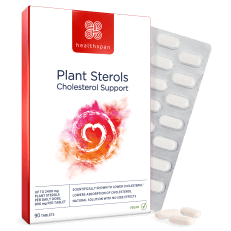Everything you need to know about cholesterol, including what it is, how it affects your heart and how to tell the good type from the bad (and everything in between).
🕒 8 min read
Cholesterol is a waxy blood fat, or lipid, that forms part of the membrane surrounding every cell in our bodies. Amazingly cholesterol was discovered in furred arteries (a condition called atherosclerosis) as long ago as 1910 and by the 1950s was recognised as a key risk factor for heart disease.
A Healthy Ireland Survey conducted in 2023 found that 5% of people in Ireland have high cholesterol – that's around 328,000 people.
What does cholesterol do?
Cholesterol provides our cells with stability and fluidity. It acts as a building block for the synthesis of hormones, such as the stress hormone cortisol, and the bile acids, which help us to digest fats. It also helps make vitamin D, essential for strong, healthy bones, teeth and muscles and other bodily functions.
Cholesterol transport
Our bodies have a finely tuned transport system to ensure cholesterol levels remain in balance. Cholesterol is packed into parcels called lipoproteins (a mixture of fat and protein) and distributed to cells via the bloodstream. Any unused cholesterol is picked up and taken back to the liver for recycling.
This process can be derailed by several factors including a poor diet and unhealthy lifestyle, and becomes less efficient as we age. When this happens cholesterol spends longer in the bloodstream and can stick to the lining of the arteries (endothelium) causing them to become furred and narrowed (atherosclerosis). High blood pressure can roughen the endothelium, making it easier for cholesterol to stick to it.
Where does cholesterol come from?
Most cholesterol in our bodies is synthesised in the 'metabolic power station' that is the liver. A small amount of cholesterol is found in foods such as eggs and shellfish. However, these contribute to only a small amount of cholesterol in our bodies.
Most of the cholesterol from food is derived from saturated fatty acids (SFA), fats that are hard at room temperature and are found in meat, butter and dairy foods as well as foods containing these such as cakes and biscuits.
SFAs can change how the liver processes cholesterol, preventing 'bad' LDL cholesterol receptors in the liver from working properly, resulting in cholesterol accumulating in the blood.
What are the different types of cholesterol?
There are several different types of cholesterol, but most cholesterol research has focused on two main types, as well as another lipid type called triglycerides.
LDL (low density lipoprotein) cholesterol
LDL carries cholesterol in the bloodstream to wherever it is needed for cell repair. LDL cholesterol is sometimes known as 'bad' cholesterol because high levels are linked with diabetes, high blood pressure, atherosclerosis and high levels of triglycerides – another blood fat involved in heart problems.
HDL (high density lipoprotein) cholesterol
HDL carries cholesterol back to the liver and the intestines to be processed and excreted in faeces. HDL cholesterol is sometimes known as 'good' cholesterol because it helps counter furring and narrowing of the arteries and has anti-inflammatory properties. Women have higher HDL cholesterol on average than men.
Triglycerides
These store energy and help insulate cells, as well as aid absorption of fat-soluble vitamins. They are produced in the liver from carbohydrates and free fatty acids (FFAs): fatty compounds formed when fats break down. They are absorbed into the body via the small intestine.
Other types of cholesterol and blood fats, collectively called non-HDL cholesterol, are now factored into your blood fat profile. These include:
- VLDL (very low density lipoproteins) containing 10% protein and 90% fat. VLDL transport triglycerides and some cholesterol from the liver. Greater production and secretion of VLDL, or changes in the way VLDL is regulated, play a direct role in atherosclerosis and heart disease. High fat consumption has been linked with higher VLDL secretion, usually manifested as high blood triglyceride levels.
- IDL (Intermediate density lipoproteins) contain levels of fat, somewhere between LDL and VLDL. IDL carries cholesterol and triglycerides, but some triglycerides have been removed.
- Chylomicrons are the largest lipoprotein with the lowest protein content. Chylomicrons are produced in enterocytes: cells that line the walls of the intestines and form a chemical barrier through which food has to pass. They have a central fatty core consisting mainly of triglycerides, with some cholesterol and other fatty chemicals.
- LP lipoprotein (a) is a large and extremely 'sticky' lipoprotein similar to LDL cholesterol. It contains two other proteins, ApoB, and Apo(a), thought to be involved in blood clotting. A high level of LP (a) is implicated in atherosclerosis, heart attack, stroke, peripheral arterial disease, aortic valve disease and heart failure.
What is a healthy cholesterol level?
It depends on your age, risk of heart disease, health status and other factors. As a general rule the figures in the table below are the ideal levels for healthy adults in the Ireland. If you have diabetes or heart disease, target levels may be lower. Check with your doctor.
Type of cholesterol | Millimoles per litre (mmol/L) |
Total cholesterol (TC) | Less than 5.00 |
Non-HDL cholesterol | Less than 4.00 |
LDL cholesterol | Less than 3.00 |
HDL cholesterol | More than 1.00 (men) More than 1.2 (women) |
TC:HDL ratio | More than 6.00 is high risk. The lower the better. |
Ideal triglyceride levels
Triglyceride | Measurement in mmol/L |
Fasting triglyceride | Less than 1.7 |
Non-fasting triglyceride | Less than 2.3 |
What causes high cholesterol?
High cholesterol – medically called hypercholesterolaemia – can be caused by our genes, diet, stress, a sedentary lifestyle, medications, and other medical problems such as hypothyroidism (low levels of thyroid hormones.) A condition called familial hypercholesterolemia (FH) is caused by specific inherited faulty genes (mutations) that affect how the body processes cholesterol.
What are the consequences of high cholesterol?
High or unbalanced levels of cholesterol and other blood fats are linked with a higher risk of heart and circulatory diseases such as angina, heart attacks, strokes, peripheral arterial disease (PAD) and vascular dementia.
Plant Sterols 800 mg
Shown to maintain or lower cholesterol
- Helps reduce absorption of dietary cholesterol
- One tablet a day maintains normal cholesterol levels
- Three tablets a day (2.4 g) lowers cholesterol levels
How can I restore my cholesterol balance?
A combination of lifestyle changes, medications, supplements or a combination of these is the best way forward.
1. Follow a Mediterranean diet
This diet is linked with a lower risk of heart disease, small reductions in cholesterol, plus lower levels of inflammation – one of the drivers of atherosclerosis. Put a wide variety of veg, pulses, fish, wholegrains, nuts, fruit and fermented dairy foods such as yogurt and cheese on your menu. If you drink alcohol, moderate wine consumption is fine. But go easy on red meat.
2. Keep your omega 3s up
A 2017 study found that oily fish – think herring, mackerel, salmon and sardines rich in omega-3 fatty acids – significantly improved triglycerides and HDL levels. The authors conclude that this evidence 'strongly support(s) the important role for oily fish as part of a healthy diet.' Put fish on the menu at least a couple of times a week and make one oily.
3. Cut back on butter, full-fat milk and cream
There is ongoing controversy around the role of saturated fatty acids (SFA), as found in the above, in heart disease. A 2021 expert commentary suggests that SFA may affect underlying contributors to heart disease such as inflammation, heart rhythm and HDL function, rather than simply lowering LDL cholesterol.
The authors recommend replacing SFA with polyunsaturated fatty acids (PUFA) found in nut and seed oils and oily fish. However, they also observe 'an overall cardioprotective dietary pattern with an emphasis on high-quality foods is more important than specific nutrients, such as SFA.'
4. Watch your weight and waist
Obesity (BMI 30 or more) and a high waist circumference (WC) is linked with an unfavourable blood fat profile and higher risk of heart disease. White European, black African, Middle Eastern or of mixed origin? Aim for a WC below 94cm/37in for men, and below 80cm/31.5in for women. African-Caribbean, South Asian, Chinese or Japanese origin? Aim for these same measurements but bear in mind that anything above these is very high risk.
5. Sit less and move more
Spending less time sitting, together with a moderate amount of intense physical activity, could improve your blood fat profile, especially levels of HDL and triglycerides, according to a 2015 study. A 2018 review recommends frequent moderate-intensity aerobic exercise for people who sit a lot to avoid risks linked with imbalances in blood fats. Think anything that gets you slightly out of breath and sweaty, such as brisk walking, doubles tennis, dancing or even pushing a lawnmower.
6. Consider plant sterols
There's strong evidence that plant sterols and stanols, naturally occurring substances with a similar molecular structure to cholesterol, can lower cholesterol. You can find small amounts in plant-based foods such as vegetable oils, seeds, nuts, legumes, grains and fruit and vegetables, but it's not possible to get enough from diet alone.
Fortified foods such as yogurts, spreads and milk, and/or dietary supplements, can fill the gap. Aim for between 1.5g and 3g of sterols and stanols daily to lower blood cholesterol levels by between 7% and 12.5%. Benefits increase incrementally up to 3g of plant sterols each day.
7. Medication matters
Although lifestyle changes can help, they don't always do enough, and some people will need medication. Statins, which work by lowering LDL cholesterol and inflammation, are agreed to be the most effective medication for preventing coronary heart disease, heart attack, stroke, and premature death.
However, they don't suit everyone. The newer medication ezetimibe lowers cholesterol levels by 20-25% with relatively few side effects. It disrupts the cholesterol transport system (see above) that carries cholesterol made in the liver or from food around the body. Other medications are also now available, so ask your doctor for advice.
Can I use plant sterols if I'm taking statins?
Yes. In fact, because statins and plant sterols work in different ways to reduce blood cholesterol, combing the two can have added benefits. Do tell your doctor if you take a plant sterol supplement or have added a fortified product containing plant sterols or stanols to your diet, as this could affect the dose of statins prescribed.








